In the digital age, where social media platforms have become the epicenters of brand marketing, user engagement, and content dissemination, leveraging the power of artificial intelligence (AI) has never been more paramount. The landscape of social media is evolving at an unprecedented pace, and with that evolution comes an influx of data, diverse user behavior, and an insatiable demand for fresh and engaging content. The year 2024 — leading into 2025 — has ushered in a suite of sophisticated AI tools designed to navigate this complex milieu. These tools are not just luxuries; they’re necessities for those wishing to remain at the forefront of the social media domain.
Whether it’s crafting tailored content that resonates with a specific audience, automating posts to ensure round-the-clock engagement, analyzing vast amounts of user feedback for sentiment analysis, or predicting the next viral trend, AI tools are the linchpins that make these tasks feasible and effective. This article delves into the best AI offerings in 2025 that are redefining the paradigms of social media content creation, management, and beyond. Join us as we explore the digital toolkits that are shaping the future of online interactions.

Best AI Tools for Social Media in 2025
- Best AI Tools for Content Creation
- Best AI Tools for Research
- Best AI Tools for Image and Video Creation
- Best AI Tools for Sentiment Analysis
Best AI Tools for Content Creation
In the digital age, content remains king. But with the ever-increasing demand for fresh, engaging, and timely material, creators often find themselves overwhelmed. Enter the new generation of AI tools – designed not to replace, but to enhance the human touch. From brainstorming ideas to refining captions, from generating articles to optimizing social media posts, artificial intelligence is revolutionizing the content landscape. This section delves into three standout platforms: ChatGPT, Writesonic, and Flick. Let’s explore what these innovative tools have in store.
ChatGPT: The Social Media Content Creator’s Secret Weapon
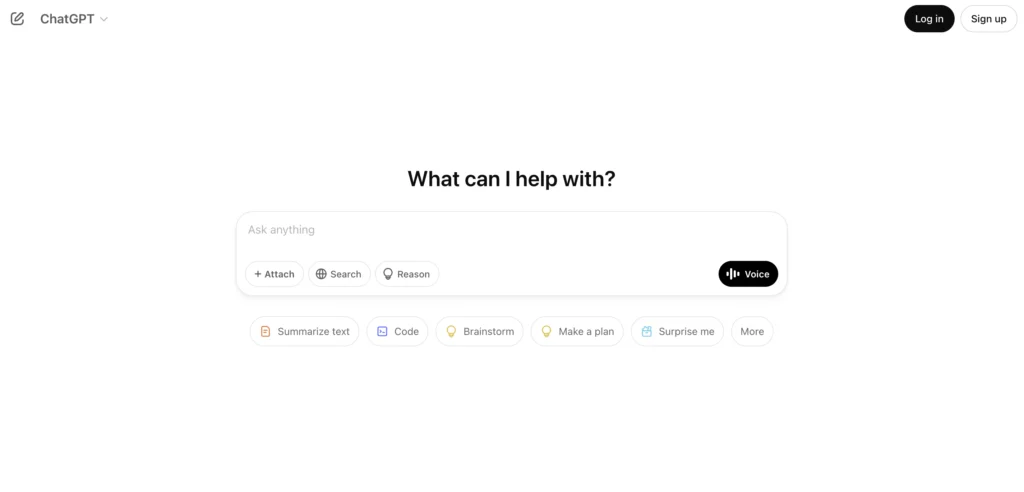
ChatGPT, developed by OpenAI, is one of the most advanced conversational AI models available. Beyond its primary purpose of engaging in detailed and nuanced conversations, it can be an invaluable asset for social media content creators. When you think of ChatGPT, you might picture AI-driven chats. But here’s a twist: imagine using it to craft a killer tweet or brainstorm the next trending hashtag.
How ChatGPT Amplifies Social Media Content Creation:
- Idea Generation: Stuck on your next Instagram theme? ChatGPT could suggest, for instance, a retro 90s week, complete with mood board ideas and catchy captions.
- Drafting Posts: Crafting that perfect Facebook post can be daunting. ChatGPT can be your co-writer. Think: “Need a playful caption for your dog’s photo? How about ‘Pawsitively adorable!’?”
- Engagement: For a brand like Nike, imagine automated responses to product queries in comments. A user might ask about shoe durability, and ChatGPT can provide a concise, brand-consistent answer.
- Language Translation: Let’s say you have a large Spanish-speaking follower base. While it’s no professional translation tool, ChatGPT can quickly turn “Thank you for your support!” into “¡Gracias por tu apoyo!”
- Content Research: Writing a LinkedIn article on AI ethics? Engage in a back-and-forth with ChatGPT to get different viewpoints and key points to consider.
The Good and the Not-So-Good of ChatGPT:
Pros:
- Jack of All Trades: From drafting tweets for a bakery’s fresh croissants to suggesting LinkedIn polls about remote work, its applications are vast.
- Budget Friendly: ChatGPT might be more feasible than hiring a full-time content strategist.
- Time in Your Pocket: Instead of spending hours brainstorming, get a headstart with ChatGPT’s suggestions.
- Tailor-Made Content: With fine-tuning, ChatGPT can sound more like “Yoga Zen Studio” and less like a generic AI.
Cons:
- A Grain of Salt: ChatGPT once suggested a “beach day” post during winter. It’s advanced but not foolproof.
- The Human Element: Relying solely on AI can miss the nuances and emotions a human creator brings.
- Repeat Offender: Without careful guidance, you might find similar content ideas popping up.
- Expertise Boundaries: It can give a quick overview of “vegan leather”, but for an in-depth look, human research remains unbeaten.
Pricing: You can use ChatGPT for free, but users who need faster response speed and access to GPT-4 may want to upgrade to the $20/month subscription.
With these real-world scenarios, it’s clear that ChatGPT can be a game-changer in social media content creation, though it’s essential to blend its capabilities with human creativity and intuition.
Writesonic: More Than Just An AI Writer

Stepping into the vast world of AI-assisted content creation, Writesonic emerges as a tool specifically tailored for marketing and content creation needs. From catchy ad headlines to detailed blog drafts, it’s built to supercharge the content creation process.
How Writesonic Empowers Social Media Content:
- Ads Creation: Need a headline for a Facebook ad about eco-friendly shoes? Writesonic might suggest something catchy like “Step into a Greener Tomorrow!”
- SEO Optimization: Crafting a blog post about homemade pasta? Writesonic can suggest SEO-optimized headers and even snippets to make the content rank-worthy.
- Landing Page Content: Launching a new e-book? The platform can draft compelling content for landing pages that will drive subscriptions or purchases.
- Email Campaigns: When targeting subscribers for a winter sale, Writesonic can whip up persuasive email copy, ensuring higher open rates.
- Article Outlines: For in-depth content on topics like “The Future of Renewable Energy”, it provides structured outlines to kickstart the writing process.
Pros:
- User-Friendly Interface: Many users appreciate its intuitive dashboard and simple design.
- Diverse Templates: The platform offers a variety of writing templates, catering to different marketing needs.
- Quick Iterations: The ability to generate multiple content variations helps in A/B testing or finding the perfect phrasing.
Cons:
- Occasional Generic Outputs: Some users noted that without fine-tuning, the content can occasionally feel generic.
- Price Point: Depending on the usage, some users found the subscription model a tad expensive, especially for small businesses or individual freelancers.
- Dependence on User Input: The quality of output often depends on the quality and specificity of user input.
Pricing: They offer a free plan with 10,000 words per month and GPT-3.5, an Unlimited plan for $16/month, and a Business plan with GPT-4 for $12.67/month (when paid annually).
How It Differs from ChatGPT:
- Purpose-Built: While ChatGPT is a conversational AI with diverse applications, Writesonic is tailored mainly for content creation and marketing tasks.
- Platform and Interface: Writesonic provides a dedicated platform with specific templates and tools for content creation. ChatGPT, on the other hand, is more open-ended and versatile in its conversational format.
- Refinement: Writesonic is built on GPT-3, while ChatGPT is based on a more advanced architecture (as of this writing), which might influence the depth and nuance of content generated.
Flick’s AI Social Media Tool: Streamlining the Social Media Creation Process
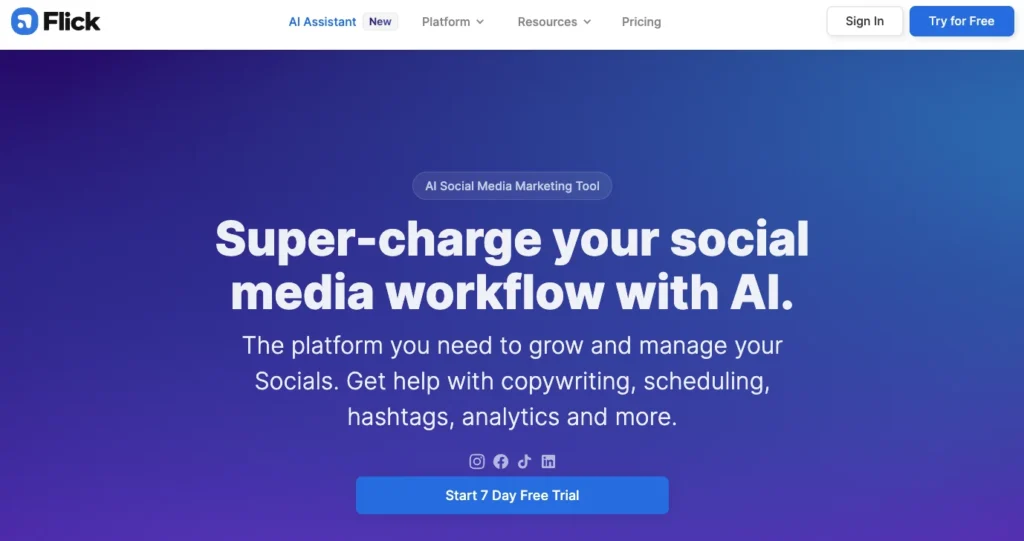
Flick serves as a practical tool, particularly for those immersed in social media content creation. The essence of the platform lies in its ability to facilitate faster and more scalable content generation. It aids users in crafting personal and brand-aligned captions more efficiently than traditional methods, positioning itself as if one had an on-demand copywriter.
The main attraction of Flick’s AI Social Media Assistant is its capacity to expedite the brainstorming, writing, and planning stages of content creation. Rather than dedicating extensive hours to ideation, users can input topics and promptly receive engaging and original content suggestions. The goal is not merely to assist but to elevate users’ copywriting capabilities, allowing them to produce compelling captions in a shorter timeframe, all the while preserving their distinct voices.
Pros:
- Brainstorming Assistance: Instead of facing the blank slate syndrome, users can input topics and, within moments, receive engaging content ideas tailored to their audience’s interests.
- Elevating Your Copy: Writing captivating captions can be a time-consuming endeavor. Flick’s AI aids in this process, enabling users to craft meaningful and attention-grabbing copy without demanding extensive writing expertise.
- Structured Planning: Beyond generating content, the platform’s ‘Content Planner’ offers an organized space to keep track of ideas, whether they’re mere thoughts or detailed posts. This structured approach ensures consistency and a cohesive content strategy.
- Optimization and Scheduling: The tool goes a step further by suggesting optimal posting times and engagement strategies, ensuring content not only reaches but resonates with its intended audience.
- Advanced Hashtag Tools: When preparing an Instagram post, Flick offers auto-generated hashtags aligned with the content and caption. This feature taps into Flick’s comprehensive hashtag capabilities, assisting users in optimizing their posts for better reach and engagement.
Cons:
- Initial Familiarity: As with any tool, users may require some time to acclimate to Flick’s features and interfaces.
- Ensuring Authenticity: There’s a continual need to balance the automated assistance with personal touch, ensuring content doesn’t come off as too formulaic.
- Platform Considerations: Some of Flick’s features might lean more toward specific platforms, posing potential challenges for those diversifying their social media presence.
Pricing: They have three different plans for £11, £24, and £55/month respectively when billed yearly.
Jasper AI: The Ultimate Tool for High-Quality Long-Form Content Creation

Jasper AI is a versatile content creation platform designed to help marketers, bloggers, and businesses produce high-quality copy faster and more efficiently. Powered by advanced language models, Jasper AI excels in generating blog posts, social media captions, ad copies, and email marketing content. Its intuitive interface and customization options make it a go-to choice for content creators looking to maintain consistency in brand voice while boosting productivity.
Key Features:
- Versatile Content Templates: Over 50 templates tailored for blogs, social media posts, ads, emails, and more.
- Boss Mode: Enables long-form content generation with greater control, allowing users to dictate tone, style, and structure.
- Team Collaboration: Multi-user support with shared workspaces, ideal for marketing teams and agencies.
- Plagiarism Checker: Built-in integration to ensure unique content.
- SEO Optimization: Integration with tools like Surfer SEO for better ranking and visibility.
Pricing Plans:
- Starter Plan: $49/month – Suitable for short-form content like social media posts and ad copies.
- Boss Mode: $99/month – Ideal for long-form content creation, including blog posts, reports, and more detailed articles.
- Business Plan: Custom pricing – Designed for larger teams with collaborative features and personalized support.
- Free Trial: A 7-day free trial is available for new users to explore its features before committing.
Pros:
- High-Quality Output: Consistently generates engaging and coherent content.
- Easy to Use: User-friendly interface with intuitive navigation and template options.
- SEO Integration: Direct integration with Surfer SEO to optimize content for search engines.
- Team Collaboration: Supports multi-user environments, enhancing productivity for agencies and teams.
- Customizable Tone and Style: Allows users to adjust tone and writing style to match brand voice.
Cons:
- Higher Price Point: More expensive compared to some competitors, especially for Boss Mode.
- Learning Curve: Advanced features require some time to master.
- Limited Creativity in Complex Topics: Occasionally struggles with highly technical or nuanced subject matter.
How Jasper AI Compares to Other Content Creation Tools: Compared to ChatGPT and Writesonic, Jasper AI stands out for its extensive library of templates and its Boss Mode, which offers more control over long-form content. While ChatGPT excels in conversational writing and Writesonic offers cost-effective plans, Jasper AI provides a more comprehensive solution for brands needing consistent, high-quality content. In contrast to Flick, which specializes in social media captions, Jasper AI’s versatility makes it suitable for a broader range of content types, from blog posts to ad campaigns.
Why Choose Jasper AI? Jasper AI is ideal for businesses and marketers looking for a reliable, efficient way to create high-quality content at scale. Its advanced features and SEO integration make it perfect for those seeking to enhance their digital marketing strategies. However, the higher price point may not be suitable for smaller budgets.
Perfect For:
- Content marketers looking for consistent brand voice across multiple platforms.
- Agencies needing collaborative tools for team productivity.
- Bloggers and writers aiming to produce long-form content quickly and efficiently.
Jasper AI remains one of the top choices for content creation in 2025, providing a powerful blend of versatility, efficiency, and quality.
Copy.ai: The Best AI Tool for Fast and Engaging Copywriting

Copy.ai is a powerful AI writing assistant designed to help marketers, entrepreneurs, and content creators produce captivating copy in minutes. Specializing in short-form content, Copy.ai excels at generating social media posts, email subject lines, ad copies, and product descriptions. Its easy-to-use interface and creative prompts make it a popular choice for those looking to overcome writer’s block and craft persuasive content with minimal effort.
Key Features:
- Versatile Content Templates: Over 90 templates for social media posts, emails, product descriptions, blog intros, and more.
- Instant Inspiration: Built-in brainstorming tools to help generate ideas and overcome creative block.
- Tone Customization: Easily adjust the tone of voice to match brand identity, from friendly and casual to professional and authoritative.
- Long-Form Content Mode: While primarily known for short-form copy, Copy.ai also supports basic long-form content creation.
- Multi-Language Support: Generates content in over 25 languages, making it suitable for global marketing campaigns.
Pricing Plans:
- Free Plan: Basic access with 2,000 words per month, perfect for testing its capabilities.
- Pro Plan: $49/month – Unlimited words, priority support, and advanced writing features.
- Team Plan: Custom pricing – Designed for collaborative teams with shared workspaces and enhanced productivity tools.
- 7-Day Free Trial: Available for the Pro Plan to explore premium features risk-free.
Pros:
- Quick and Easy to Use: Simple interface that allows users to generate copy with just a few clicks.
- Great for Short-Form Content: Particularly effective for social media posts, ad copies, and email marketing.
- Affordable Pricing: Competitive pricing compared to other content creation tools.
- Multi-Language Capabilities: Ideal for businesses targeting international audiences.
- Creativity and Variations: Offers multiple versions of content for users to choose from, enhancing creative flexibility.
Cons:
- Basic Long-Form Content: Less powerful for long-form content compared to tools like Jasper AI.
- Occasional Repetitiveness: Some users report repetitive outputs, requiring manual editing.
- Limited SEO Features: Lacks advanced SEO integration for optimized content creation.
How Copy.ai Compares to Other Content Creation Tools: Compared to Jasper AI, Copy.ai is more focused on short-form content and is generally easier to use with a quicker learning curve. While Jasper AI excels in long-form writing and SEO integration, Copy.ai is perfect for quick social media posts, ad copies, and email subject lines. It also offers more language support compared to Writesonic, making it a better choice for international campaigns. However, for users looking for advanced long-form content creation or detailed SEO optimization, ChatGPT and Jasper AI might be more suitable alternatives.
Why Choose Copy.ai? Copy.ai is the go-to tool for marketers and content creators who need fast, engaging, and persuasive short-form copy. Its ease of use and creative templates make it a favorite for social media managers, startups, and small businesses. The affordable pricing and multi-language support also make it a great choice for global marketing efforts.
Perfect For:
- Social media managers looking to create engaging posts quickly.
- Marketers who need compelling ad copies and email subject lines.
- Small business owners seeking cost-effective marketing solutions.
- Teams working on global campaigns needing multi-language support.
Copy.ai shines as the best choice for quick, catchy, and effective short-form content, making it a must-have tool for modern marketers in 2025.
Best AI Tools for Research
Crafting compelling and relevant content for social media often requires a deep dive into topics, trends, and current events. It’s essential to ensure that the content resonates with audiences while being accurate and informed. In this pursuit, AI-powered research tools are becoming indispensable. They streamline the process of gathering information, identifying authoritative sources, and even suggesting content angles based on current discourse. For social media professionals, influencers, and content creators, this means less time sifting through pages of search results and more time crafting impactful posts. In this section, we’ll explore the top AI tools that are reshaping the way we do research for social media content, making it faster, smarter, and more tailored to audience interests.
DeepSeek: Best AI Tool for Research in 2025

DeepSeek is a rapidly emerging AI platform known for its cost-effective and powerful models, designed to rival the industry giants at a fraction of the cost. Founded in 2023 by Liang Wenfeng, a former hedge fund manager, DeepSeek has made waves with its open-source approach and innovative AI models, including DeepSeek-V3 and DeepSeek-R1, which excel in logical reasoning, mathematical problem-solving, and real-time analysis.
Key Features:
- Advanced AI Models: DeepSeek-V3 with 671 billion parameters and DeepSeek-R1 for logical reasoning and real-time problem-solving.
- Open-Source Philosophy: Full access to model architecture and training details, fostering global collaboration.
- Cost-Efficiency: Significantly lower pricing compared to competitors, with flexible token-based billing.
- Security and Privacy: Enhanced measures, although past data exposure incidents highlight ongoing challenges.
- Local Censorship Mechanisms: Content filtering on politically sensitive topics, particularly in China.
Pricing Plans:
- DeepSeek-Chat Model:
- Input Tokens: $0.07 (Cache Hit) / $0.27 (Cache Miss) per 1 million tokens
- Output Tokens: $1.10 per 1 million tokens
- DeepSeek-Reasoner Model:
- Input Tokens: $0.14 (Cache Hit) / $0.55 (Cache Miss) per 1 million tokens
- Output Tokens: $2.19 per 1 million tokens
- Free Plan: Ideal for exploring capabilities without upfront costs.
Pros:
- Affordable Pricing: Significantly cheaper than industry leaders like OpenAI.
- High-Performance Models: Competitive accuracy and efficiency in complex reasoning tasks.
- Open-Source Collaboration: Encourages innovation and community-driven development.
- Flexible Usage Plans: Token-based pricing provides cost control and scalability.
Cons:
- Security Concerns: Past incidents of data exposure, though promptly addressed.
- Censorship Constraints: Restricted outputs on sensitive topics, influenced by Chinese regulations.
- Relatively New Player: Rapid growth but still gaining global trust and adoption.
Why Choose DeepSeek? For researchers and professionals seeking a cost-effective, high-performance AI solution, DeepSeek offers an exceptional balance of power and affordability. Its advanced reasoning models and open-source strategy make it a standout choice for those looking to innovate without breaking the bank. However, potential users should be aware of regional censorship limitations and ongoing security improvements.
Perfect For:
- Academic researchers needing logical inference and complex problem-solving.
- Businesses looking to integrate AI with lower operational costs.
- Developers interested in customizing and collaborating on open-source AI projects.
DeepSeek is proving itself as a serious contender in the AI landscape, especially for research-focused applications. Its blend of powerful models, open-source transparency, and unbeatable pricing makes it a top pick for 2025.
Consensus: Delving into Evidence-Based AI Search

Consensus emerges as a cutting-edge AI-powered search engine, distinctively designed to mine scientific research and deliver evidence-based answers to user queries. Underpinning its vast capabilities is the renowned GPT-4, an AI model noted for its profound comprehension and extensive data grasp.
Key Features:
- AI-powered Academic Search: Beyond traditional search methods, Consensus dives deep into the world of academic exploration. Upon posing a question, it meticulously searches millions of scholarly publications, delivering answers replete with comprehensive references. Users benefit from the flexibility to modify search preferences, categorize results based on diverse criteria, and even evaluate and offer feedback on the sources they peruse.
- GPT-4 Summary: The synergy between Consensus and GPT-4 introduces an innovative approach to scientific summarization. When a query is posed, the system harnesses GPT-4 to pinpoint and extract crucial insights, offering users a summary derived from the foremost 5-10 results. What sets it apart is its commitment to transparency: while users receive a streamlined summary, the foundational results—all sourced from esteemed journal articles—are also made accessible for deeper exploration.
- Consensus Meter: If you’re ever curious about prevailing opinions on a particular subject, the Consensus Meter comes into play. Employing vast language models, it collates responses to binary questions, presenting them as “yes,” “no,” or “possibly.” It serves as an indispensable tool to gauge prevailing sentiments or determine consensus on myriad topics.
User Experience:
User reviews from platforms like ProductHunt laud its ability to streamline research processes, especially for those who value evidence-based content. These are the main pros and cons mentioned:
Pros:
- Users appreciate the direct answers, noting that it often saves them from sifting through multiple links.
- Many have highlighted the user-friendly interface, emphasizing its simplicity and intuitive design.
- The tool is recognized for improving efficiency, especially for those needing quick answers without deep dives.
Cons:
- A few users have flagged occasional discrepancies in the provided answers.
- It’s observed to excel with factual queries, but might fall short with subjective or nuanced questions.
- A few users have expressed the desire for more advanced search options or filters.
Pricing: They have a free plan with unlimited searches, three summaries, and three consensus meters per month, but if you want unlimited summaries and more features, you’ll need the Premium plan for $7.99/month when billed annually or the custom Enterprise plan.
Research Rabbit: The Efficient Path to Academic Mastery
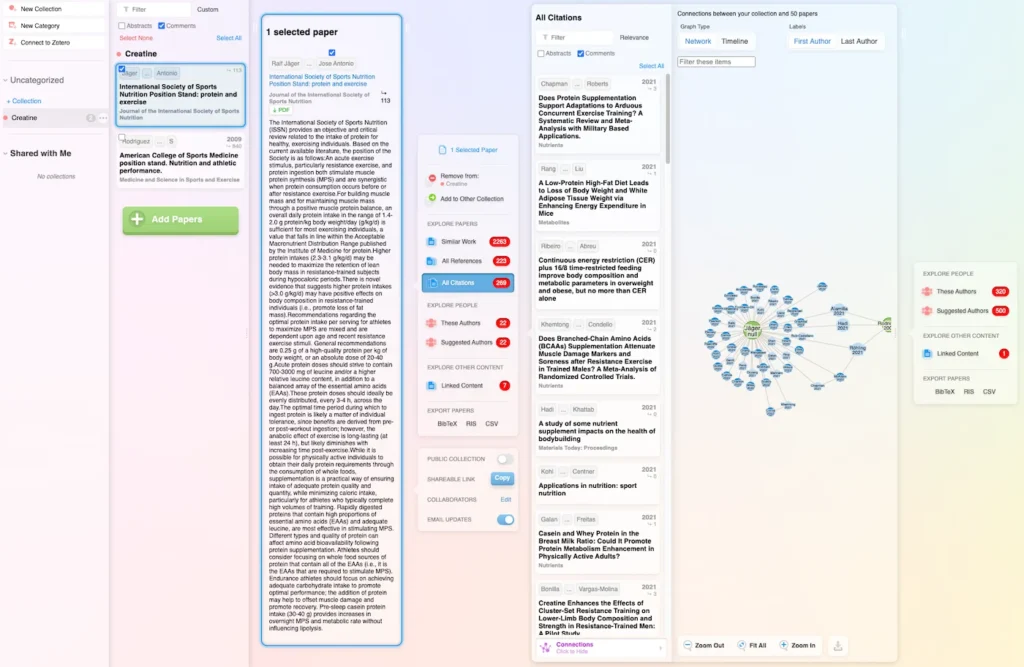
Delving into academic literature can often feel like venturing down a never-ending rabbit hole. Research Rabbit, touted as the “Spotify of research,” has emerged as a game-changer, offering an innovative approach to literature exploration. This platform streamlines the research process, ensuring students and scholars alike find relevant papers with ease.
Key Features
- Collections for Personalized Recommendations: By adding papers to “collections,” Research Rabbit discerns a user’s interests and suggests related content. This personalization aspect ensures a more targeted exploration of literature.
- Visualizing Scholarly Networks: With a distinct feature that displays the interlinked network of papers and co-authorships, users can trace a topic or an author’s work, diving deep into specific research facets.
- Intuitive Column-based UI: The platform’s user interface is groundbreaking. Users can swiftly transition from one paper to another, accessing citations, references, and related papers within split-second clicks. This column-based approach encourages efficient and effortless browsing.
- Co-authorship Graphs: As one of the first tools to support co-authorship visualizations, Research Rabbit provides another layer to literature exploration, allowing users to uncover works through author connections.
- Citation Visualizations: While exploring numerous papers, it’s easy to lose track. Research Rabbit’s default visualization exhibits a clear citation network, color-coding the papers in your collection. It serves as a reminder of your journey and how far you’ve ventured from your initial point.
- Note-taking & Highlighting: Not just a browsing tool, Research Rabbit facilitates note-taking and highlighting. This built-in functionality lets users distill crucial insights directly within the platform, readying them for literature reviews.
- Universal Access: The platform’s cloud-based design allows access from any location with internet connectivity. This flexibility caters to the diverse schedules of its users, ensuring they can delve into research anytime, anywhere.
Pros
- Time-saving: With its efficient search tools, Research Rabbit cuts down the hours people traditionally spend on research.
- User-friendly Interface: The platform is designed for easy navigation, accommodating both research novices and seasoned scholars.
- Integrated Note-taking: Directly summarizing and extracting pivotal information enriches the research process.
- Flexible Access: Whether you’re at a library, coffee shop, or home, Research Rabbit is just a click away.
Cons
- For some users, the column-based approach, while innovative, might require a bit of an initial learning curve.
- Heavy reliance on visualizations might not cater to those who prefer traditional list-based browsing.
Pricing: Free
Comparative Analysis with Consensus
While both Research Rabbit and Consensus are designed to streamline the research process, they cater to slightly different needs. Consensus leans towards AI-driven academic search, leveraging GPT-4 to distill data directly from scientific research. Its emphasis is on delivering evidence-based answers to user queries. Research Rabbit, on the other hand, focuses on enhancing the user’s journey through academic literature. Its column-based UI, co-authorship graphs, and citation visualizations stand out, offering a more interactive and intuitive exploration of literature.
Elicit: The Best AI Tool for Evidence-Based Research

Elicit is an AI-powered research assistant designed to help academics, analysts, and professionals find relevant studies, summarize findings, and generate evidence-based insights. Developed by the team at Ought, Elicit specializes in literature reviews, hypothesis generation, and systematic analysis, making it an indispensable tool for data-driven research. Its intelligent search and summarization capabilities save countless hours spent sifting through academic papers, ensuring users stay informed with the most credible and relevant sources.
Key Features:
- Smart Literature Review: Automatically finds and summarizes academic papers relevant to your research questions, streamlining the literature review process.
- Evidence Extraction: Extracts quantitative data from studies, making it easier to compare results and draw meaningful conclusions.
- Hypothesis Generation: Suggests hypotheses based on existing research, helping users explore new research avenues.
- Customizable Research Workflows: Allows users to tailor search criteria, filters, and sorting options to meet specific research needs.
- Collaborative Research Environment: Supports team collaboration with shared workspaces and commenting features, ideal for academic groups and research teams.
Pricing Plans:
- Free Plan: Full access to core features with limitations on the number of searches and summaries per month.
- Pro Plan: $29/month – Increased usage limits, priority support, and more advanced customization options.
- Team Plan: $99/month – Designed for research teams with collaborative tools, enhanced sharing options, and administrative controls.
- Enterprise Plan: Custom pricing – Tailored for large organizations and academic institutions with dedicated support and security features.
Pros:
- Saves Time: Streamlines the literature review process, significantly reducing the time required to find and summarize relevant studies.
- Evidence-Based Insights: Focuses on extracting quantitative data, ensuring research conclusions are grounded in evidence.
- Customizable Searches: Flexible search filters and sorting options allow users to find the most relevant studies for their research questions.
- Collaborative Features: Facilitates teamwork with shared workspaces and real-time commenting.
- User-Friendly Interface: Intuitive and easy to navigate, even for users new to systematic reviews.
Cons:
- Limited Sources for Niche Topics: May struggle to find relevant studies on highly specialized or emerging research areas.
- Subscription Cost: The Pro and Team plans can be expensive for independent researchers on a tight budget.
- Learning Curve for Advanced Features: Some users report a learning curve when utilizing advanced customization options.
How Elicit Compares to Other Research Tools: Compared to Consensus, which focuses on finding consensus in academic debates, Elicit is more comprehensive in literature reviews and evidence extraction. While Research Rabbit is excellent for exploring research connections and discovering new papers, Elicit excels in data extraction and hypothesis generation. It also offers more collaborative features compared to other research tools, making it ideal for academic teams and research groups.
Why Choose Elicit? Elicit is perfect for researchers who need a systematic approach to literature reviews and evidence-based insights. It automates the tedious tasks of searching for relevant studies and summarizing findings, allowing users to focus on analysis and interpretation. Whether you’re a PhD student, academic researcher, or data analyst, Elicit helps you stay on top of the latest research with efficiency and precision.
Perfect For:
- Academic researchers conducting systematic literature reviews.
- Data analysts needing evidence-based insights for reports and presentations.
- Research teams collaborating on complex research projects.
- Students working on research papers, dissertations, or thesis literature reviews.
Elicit stands out as an essential tool for evidence-based research, saving time and enhancing the quality of literature reviews and data analysis. It’s a must-have for researchers in 2025 looking to stay ahead in their fields.
Scholarcy: The Best AI Tool for Academic Paper Summarization

Scholarcy is an AI-powered research assistant designed to help academics, students, and researchers quickly digest complex academic papers. It specializes in summarizing research articles, extracting key findings, and generating structured notes, making it easier to understand dense academic content. Scholarcy is particularly useful for literature reviews, helping users evaluate multiple studies efficiently. Its intuitive interface and powerful summarization capabilities save time while ensuring comprehensive understanding of the research landscape.
Key Features:
- Automatic Summarization: Condenses long academic papers into concise summaries, highlighting key arguments, methodologies, and findings.
- Flashcard Generator: Creates flashcards with essential information like objectives, methods, results, and conclusions, aiding in quick revision and knowledge retention.
- Reference Extraction: Extracts and organizes references from papers, linking them to open-access sources for seamless exploration.
- PDF and Webpage Support: Works with PDFs and web-based articles, making it versatile for different research materials.
- Structured Notes: Organizes notes by sections, allowing users to easily navigate through abstracts, introductions, methodologies, and conclusions.
Pricing Plans:
- Free Plan: Basic access with limited summaries per month, suitable for light academic use.
- Premium Plan: $7.99/month – Unlimited summaries, flashcards, and reference extraction with enhanced customization.
- Team Plan: Custom pricing – Collaborative features for research teams and educational institutions.
- Institutional Plan: Custom pricing – Tailored for universities and large organizations with administrative controls and dedicated support.
Pros:
- Saves Time on Literature Reviews: Quickly summarizes multiple papers, saving countless hours of reading.
- Easy to Use: User-friendly interface with drag-and-drop functionality for PDFs.
- Comprehensive Flashcards: Flashcards provide structured notes, ideal for studying and exam preparation.
- Enhanced Reference Management: Automatically extracts and organizes references for seamless citation management.
- Multi-Format Support: Works with both PDFs and online articles, ensuring flexibility in research sources.
Cons:
- Accuracy of Summaries: Summaries may occasionally miss nuanced arguments or interpretations, requiring manual verification.
- Limited to Academic Papers: Primarily designed for academic research, less suitable for general web content.
- Subscription Cost: While affordable, the Premium plan might be costly for students on a tight budget.
- Learning Curve for Advanced Features: Some users report needing time to fully utilize advanced customization options.
How Scholarcy Compares to Other Research Tools: Compared to Elicit, which focuses on evidence extraction and hypothesis generation, Scholarcy is more specialized in summarizing and organizing academic papers. Consensus helps find research consensus but lacks the structured note-taking capabilities of Scholarcy. While Research Rabbit excels at exploring research connections, Scholarcy stands out for its detailed summarization and reference management. Scholarcy also complements tools like Mendeley and Zotero by enhancing literature reviews with structured notes and flashcards.
Why Choose Scholarcy? Scholarcy is ideal for students, academics, and researchers who need to read and summarize large volumes of academic literature quickly. Its flashcard-style summaries enhance learning and retention, making it perfect for exam preparation and systematic reviews. The reference extraction and organization features also streamline the citation process, ensuring accurate and efficient research workflows.
Perfect For:
- Academic researchers conducting systematic literature reviews.
- Students preparing for exams or writing research papers.
- Educators looking to organize and summarize course readings.
- Researchers managing large bibliographies for dissertations or theses.
Scholarcy is a game-changer for academic research, providing structured summaries and organized notes that make complex papers more accessible and easier to understand. It’s a must-have tool for anyone navigating academic literature in 2025.
Best AI Tools for Image and Video Creation
Visual content is a driving force in today’s digital narrative, capturing attention and telling stories in ways words sometimes can’t. The demand for high-quality images and videos is incessant, but producing them requires both time and expertise. This is where AI steps in, bridging the gap between vision and execution. In this section, we’ll spotlight some of the leading AI platforms that are reshaping the way we approach visual content creation.
Midjourney: A Deep Dive into Generative AI Image Creation

Interpretation of almond-shaped eye in Midjourney
Hailing from the research lab of San Francisco-based Midjourney, Inc., Midjourney emerges as a prominent figure in the realm of generative artificial intelligence. The platform converts natural language descriptions—or “prompts”—into visual masterpieces. Since stepping into open beta on July 12, 2022, it’s proven to be a game-changer in AI-generated imagery.
Access & Usability:
Currently, Midjourney is available exclusively through a Discord bot on their official server. To generate images, users initiate the /imagine command, followed by their desired prompt. The result? A quartet of images, ready for the user to select and upscale as they see fit. A web interface is also in the development phase, promising more versatility in the future.
Pros:
- Generative AI Excellence: Midjourney’s core strength lies in its ability to convert text prompts into visually breathtaking images.
- Realistic Renderings: The images aren’t mere representations; they capture intricate details, exuding lifelike quality.
- Advanced Tech Integration: The tool merges state-of-the-art machine learning tech, including potent language and diffusion models, driving its powerful image generation.
Cons:
- A Barrier to Entry: While Midjourney promises stunning results, it does come with a learning curve, potentially intimidating to those less tech-inclined.
- Prior Free Access Concerns: The initial offer of free usage led to bottlenecks and service delays, leading to the termination of free accounts.
- Platform Restriction: As of now, it’s solely accessible through Discord, which might limit its reach to a wider audience.
Pricing:
- Initial Test Drive: A fee of $10 allows users to generate approximately 200 images, offering a taster of the platform’s capabilities.
- Standard Plan: At $30/month, users can produce unlimited images. However, this comes with the trade-off of slower processing speeds.
- Pro Plan: Priced at $60/month, this plan facilitates quicker processing, permits more simultaneous image generation tasks, and the ability to create images privately, without them being visible to others.
DALL-E: The Pioneering AI Image Generator

DALL-E, a product from OpenAI, is an innovative AI tool that metamorphoses textual prompts into captivating visual art. As one of the pioneering tools in generative image AI, DALL-E has set a significant benchmark in the AI community, merging linguistic instructions with visual outcomes.
Access & Usability:
DALL-E is accessible via a web-based interface, offering users a user-friendly and straightforward experience in image creation. With a sleek design, even novices can navigate the platform with ease, enabling them to produce images without steep learning curves.
Pros:
- Inception of AI Imagery: As a trailblazer, DALL-E’s algorithms and technology are tried and tested, boasting reliability and efficiency.
- Easy Navigation: Its web-based platform is intuitive, ensuring users of all tech levels can produce their desired images without hurdles.
- Quality Renders: The images generated are of exceptional quality, with clear details and high resolution.
Cons:
- Lesser Refinement: When pitched against newer tools like Midjourney and Stable Diffusion, DALL-E sometimes may not achieve the same level of intricate detail or image refinement.
- Limited Variations: In certain instances, DALL-E might not produce as diverse a set of image outputs in comparison to its counterparts.
Pricing: 115 credits for $15. Each text prompt that generates a set of four images requires one credit.
Stable Diffusion: A New Era in AI Imagery

Stable Diffusion, a product of Stability AI, ventures into the realm of generative image AI, vying for a prominent position. Offering capabilities similar to DALL-E and Midjourney, Stable Diffusion translates natural language prompts into a visual spectrum with its unique technological spin.
Access & Usability:
Unlike its counterparts, the specifics about the interface of Stable Diffusion are not as widely publicized, leaving a sense of mystery around its usability. However, given the competitive nature of AI tools, it’s anticipated to be user-centric.
Pros:
- High-Fidelity Images: Stable Diffusion has an edge when it comes to the fine details and nuances in the images it creates, often surpassing the competition.
- Diverse Renderings: The platform provides varied image outputs for a single prompt, ensuring users have ample choices for their visual content.
- Advanced Technology: Leveraging state-of-the-art algorithms, Stable Diffusion pushes boundaries in AI-driven image generation.
Cons:
- Limited Public Information: There’s a shroud of ambiguity around Stable Diffusion’s accessibility and interface, making it a tad elusive for potential users.
- Newcomer Challenges: Being relatively newer, it might not have the extensive user base or feedback mechanism in place compared to established tools like DALL-E.
Pricing: The Stable Diffusion credits system is a little more confusing since it depends on the number of steps and images you want to generate, as well as image size. Roughly, however, you can generate 500 SDXL images with 1,000 credits, which cost $10. You also get 25 free credits when you start.
Differences Among The Three:
- Technological Depth: While all three tools harness the power of AI for image generation, Midjourney, and Stable Diffusion are often cited to produce more refined and detailed images compared to DALL-E.
- Usability & Access: DALL-E’s strength lies in its straightforward web interface, making it accessible to a broad user base. In contrast, Midjourney is channeled through Discord, and Stable Diffusion’s access points remain more obscure.
- Image Variability: Stable Diffusion tends to offer a broader spectrum of image variations for a single prompt, followed closely by Midjourney. DALL-E, while remarkable, sometimes may not provide as diverse a set of outcomes.
Synthesia: Revolutionizing AI-Powered Video Creation
Synthesia is at the forefront of AI-driven video creation, allowing users to produce high-quality videos without the need for traditional recording equipment or actors. By harnessing the power of AI, Synthesia enables the creation of realistic-looking video content from text inputs, ushering in a new era of digital video production.
User Feedback:
Many users applaud Synthesia for its groundbreaking approach to video content generation. They frequently mention the platform’s ability to save time and resources, especially for businesses that require frequent video updates or those looking to localize content in different languages without reshooting. However, some users have pointed out that, while revolutionary, the technology isn’t perfect, and there are occasional glitches or unnatural movements in the generated videos.
Pros:
- Cost-Efficient Production: Synthesia eliminates the need for camera equipment, actors, and locations, dramatically reducing production costs.
- Multilingual Capabilities: Users can easily produce videos in multiple languages without reshooting, ideal for global businesses and campaigns.
- Rapid Content Creation: The platform accelerates the video creation process, making it possible to produce content at a faster pace than traditional methods.
- Customizability: Users have the flexibility to design avatars and scenarios to fit various themes and branding requirements.
Cons:
- Uncanny Valley Concerns: Some viewers find the AI-generated characters slightly off-putting or unnatural, a phenomenon often referred to as the “uncanny valley.”
- Occasional Glitches: There can be minor imperfections in the video output, such as awkward movements or lip-syncing issues.
- Limited Scenarios: While Synthesia offers a range of settings and avatars, there are constraints compared to what can be achieved with live-action shooting.
Pricing: $22.50/month when billed annually or $30 when paid monthly with 10 minutes of video/month and 90+ AI avatars, or a customizable plan for enterprises that need unlimited videos and more advanced collaboration features.
RunwayML: The Best AI Tool for Video Editing and Visual Effects

RunwayML is an innovative AI-powered platform designed for creatives and video editors, enabling them to produce professional-quality videos and visual effects with ease. Known for its intuitive interface and powerful features, RunwayML simplifies complex editing tasks such as rotoscoping, background removal, and motion tracking. It’s a favorite among filmmakers, social media creators, and designers who want to bring their visions to life without the steep learning curve of traditional editing software.
Key Features:
- AI-Powered Video Editing: Advanced tools for rotoscoping, green screen effects, and background removal, powered by machine learning.
- Text-to-Video Generation: Create videos from text prompts using generative AI, perfect for rapid prototyping and creative storytelling.
- Real-Time Collaboration: Cloud-based platform that allows teams to collaborate in real-time, streamlining the creative workflow.
- Versatile Integrations: Seamlessly integrates with other creative tools like Adobe Premiere Pro and After Effects.
- Multi-Modal AI Tools: Supports image synthesis, style transfer, and object detection, making it a versatile platform for multimedia projects.
Pricing Plans:
- Free Plan: Basic features with limited export resolution, suitable for beginners exploring the platform.
- Pro Plan: $12/month – Higher resolution exports, more advanced editing tools, and priority rendering.
- Team Plan: $28/user per month – Collaborative features for teams, enhanced cloud storage, and priority support.
- Enterprise Plan: Custom pricing – Designed for large creative agencies with advanced security and workflow management.
Pros:
- User-Friendly Interface: Easy to navigate, even for beginners with limited video editing experience.
- Powerful AI Features: Advanced tools like rotoscoping and text-to-video make complex editing tasks effortless.
- Real-Time Collaboration: Ideal for remote teams working on video projects.
- Cloud-Based Workflow: Access projects from anywhere, eliminating the need for powerful local hardware.
- Seamless Integration: Works well with industry-standard tools like Adobe Premiere Pro.
Cons:
- Limited Free Plan: The free version has limited export resolution and fewer features compared to paid plans.
- Learning Curve for Advanced Features: Some advanced AI tools require time to master for optimal results.
- Occasional Output Inconsistencies: Text-to-video and style transfer outputs can sometimes be unpredictable.
How RunwayML Compares to Other Image and Video Creation Tools: Compared to Synthesia, which focuses on AI-generated talking head videos, RunwayML offers a more comprehensive suite of video editing tools, including rotoscoping and background removal. While Midjourney and DALL-E excel at generating high-quality images, RunwayML stands out for its robust video editing and text-to-video capabilities. It also offers more advanced editing features than Stable Diffusion, making it ideal for professional video production.
Why Choose RunwayML? RunwayML is perfect for creatives who want to harness the power of AI for professional video editing and visual effects without a steep learning curve. Its cloud-based workflow, real-time collaboration, and advanced AI tools make it an essential tool for filmmakers, social media content creators, and digital marketing teams looking to produce high-quality video content quickly and efficiently.
Perfect For:
- Filmmakers and video editors looking for advanced rotoscoping and background removal.
- Social media creators needing quick and creative video content.
- Marketing teams collaborating on multimedia campaigns.
- Designers experimenting with AI-generated visuals and effects.
RunwayML is redefining video editing with its innovative AI tools and user-friendly platform, making it a top choice for visual storytelling in 2025.
Pictory: The Best AI Tool for Social Media Video Creation

Pictory is an AI-powered video creation tool designed for marketers, social media managers, and content creators who need to turn long-form content into short, engaging videos. It specializes in converting blog posts, articles, and even long videos into short video highlights, perfect for social media platforms like Instagram, TikTok, and YouTube Shorts. With its intuitive drag-and-drop interface and powerful text-to-video capabilities, Pictory makes it easy to create professional-looking videos without any technical expertise.
Key Features:
- Text-to-Video Conversion: Automatically turns written content like blog posts and articles into short, engaging videos with relevant visuals and voiceovers.
- Video Highlights: Extracts key moments from long videos, perfect for creating social media snippets and highlight reels.
- Built-In Library: Access to a vast collection of stock images, video clips, and music tracks to enhance video storytelling.
- Voiceover and Subtitles: AI-generated voiceovers in multiple languages and automatic subtitle generation for better engagement.
- Customizable Templates: A wide range of templates designed for social media platforms, ensuring optimized videos for different channels.
Pricing Plans:
- Free Plan: Limited access with watermarked videos, suitable for trying out the platform.
- Standard Plan: $19/month – Ideal for social media creators needing basic features and video exports in HD.
- Premium Plan: $39/month – Advanced editing tools, text-to-video features, and priority support.
- Teams and Enterprises: Custom pricing – Collaborative tools for larger teams and agencies.
Pros:
- Easy to Use: Intuitive interface with drag-and-drop functionality, suitable for beginners.
- Fast Video Creation: Quickly converts text into short videos, perfect for social media marketing.
- Cost-Effective: Affordable pricing compared to traditional video editing software.
- Multilingual Voiceovers: Supports multiple languages, enhancing global reach.
- Automatic Subtitles: Increases engagement and accessibility with auto-generated captions.
Cons:
- Limited Advanced Editing: Not as powerful as tools like RunwayML or Adobe Premiere Pro for detailed editing.
- Template Dependency: Heavy reliance on templates, which may limit creative freedom for advanced users.
- Watermark on Free Plan: The free version includes watermarks, making it less suitable for professional use.
How Pictory Compares to Other Image and Video Creation Tools: Compared to Synthesia, which focuses on AI-generated talking head videos, Pictory is designed more for social media snippets and promotional videos. It’s faster and easier to use than RunwayML, although it lacks the advanced editing features needed for complex video production. Midjourney, DALL-E, and Stable Diffusion are more focused on generating images rather than videos, making Pictory a better choice for dynamic social media content.
Why Choose Pictory? Pictory is perfect for content creators and marketers who want to repurpose long-form content into bite-sized, engaging videos without the need for advanced editing skills. It streamlines the video creation process, saving time and resources while maximizing social media impact. The text-to-video conversion and automatic highlight extraction features are particularly useful for influencers, small businesses, and digital marketers looking to enhance their online presence.
Perfect For:
- Social media managers who need quick and engaging video content.
- Bloggers and content marketers looking to repurpose written content into videos.
- Small businesses and startups seeking cost-effective video marketing solutions.
- Influencers and YouTubers wanting to create short-form video highlights.
Pictory’s fast and easy approach to video creation makes it an invaluable tool for social media marketing in 2025. Its focus on repurposing content into shareable video formats ensures maximum reach and engagement across all platforms.
Best AI Tools for Sentiment Analysis: Decoding Social Media Emotions
In the dynamic world of social media, where opinions are voiced with rapidity and reach, understanding public sentiment is crucial for brands, influencers, and researchers alike. Sentiment analysis, powered by artificial intelligence, has emerged as an invaluable tool to decode the complex tapestry of emotions, opinions, and attitudes expressed across platforms. From tweets to Instagram captions, Facebook comments, and YouTube video feedback, AI-driven sentiment analysis tools cut through the noise, delivering insights with precision and depth. In this section, we’ll dive into the best AI tools designed for sentiment analysis, illuminating how they transform vast volumes of social media chatter into actionable insights. Whether you’re aiming to gauge brand perception, track campaign impact, or simply understand your audience better, these tools promise to be your compass in the vast ocean of social media sentiments.
Brand24: A Comprehensive Lens on Real-time Sentiment
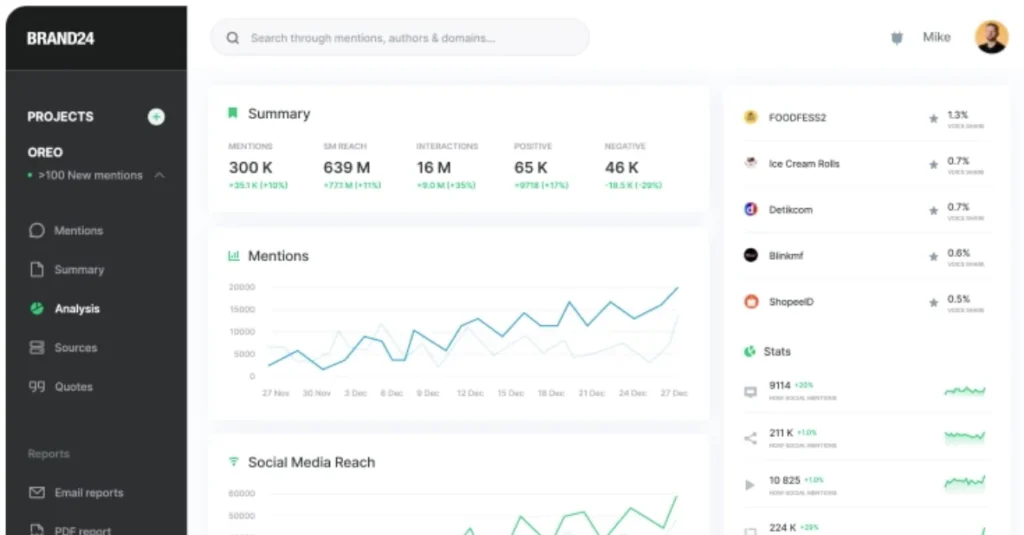
Brand24 is a versatile social media monitoring and sentiment analysis tool that enables businesses and individuals to track mentions and assess public sentiment about their brand, products, or any other specific topics. By capturing real-time data from various social media platforms, blogs, and websites, Brand24 paints a comprehensive picture of the public’s emotions and opinions.
Key Features:
- Real-Time Monitoring: Instantly capture brand mentions across various online channels.
- Sentiment Analysis: Analyze and categorize mentions as positive, negative, or neutral.
- Discussion Volume Chart: Track spikes in online conversations to identify potential PR crises or viral opportunities.
- Alerts: Get notified about negative comments, allowing for swift crisis management.
Pros:
- Intuitive interface that is user-friendly.
- Comprehensive insights derived from broad-ranging online sources.
- Reliable real-time data capture and analysis.
- Customizable alerts for efficient reputation management.
Cons:
- Some users find the pricing a bit steep for smaller businesses.
- May occasionally miss a few online mentions.
User Feedback:
Most users commend Brand24 for its easy-to-use interface and the depth of insights it provides. The real-time alerts have proven particularly beneficial for brands aiming to quickly address any negative mentions.
Pricing: Brand24 have four plans, starting at $79/month when billed annually and going up to $399/month for the Enterprise plan.
MonkeyLearn: Deep Dive into Textual Emotions
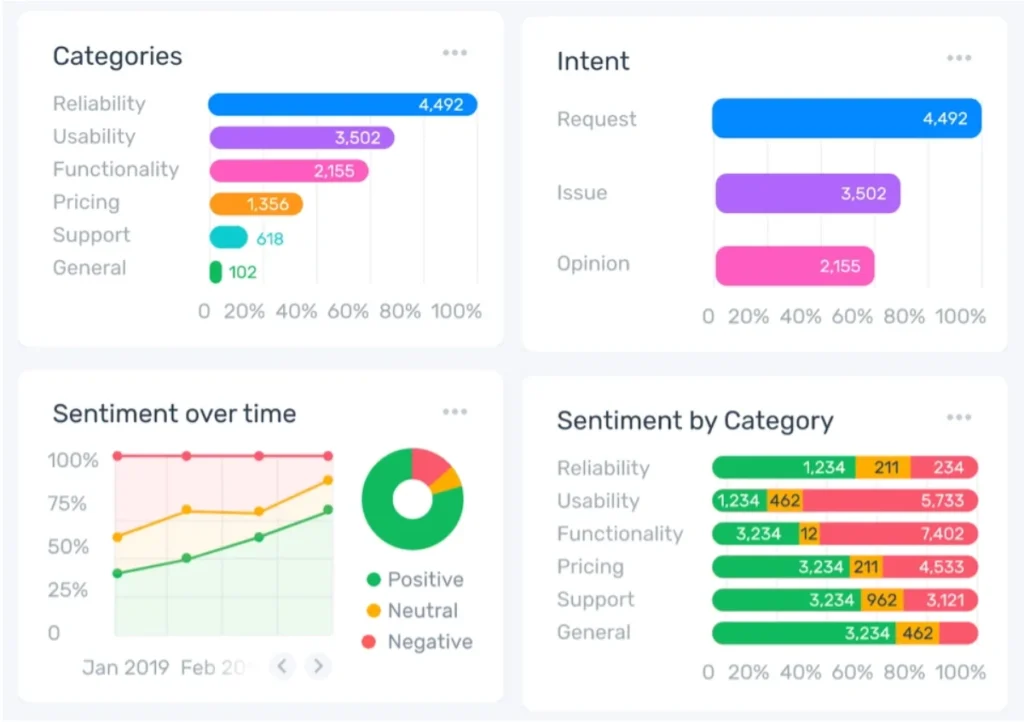
MonkeyLearn stands out as a potent AI-driven sentiment analysis tool designed to extract actionable insights from text data. While it provides a plethora of text analysis models, its sentiment analysis feature is highly esteemed for determining public emotions from social media content, surveys, reviews, and more.
Key Features:
- Custom Models: Train your sentiment analysis models based on specific business needs.
- Integrations: Seamlessly integrates with tools like Excel, Google Sheets, and Zapier.
- Visualizations: Represent sentiment data through engaging charts and graphs.
Pros:
- Offers pre-trained models, yet allows customization for niche requirements.
- Smooth integration with other popular data and productivity tools.
- Provides a deeper understanding of textual data through visualizations.
Cons:
- Requires a bit of a learning curve, especially when customizing models.
- Might not be as extensive in monitoring as dedicated social media tools.
User Feedback:
Users often laud MonkeyLearn for the flexibility it offers through custom models. However, some do mention that to leverage its full potential, a basic understanding of AI modeling is beneficial.
Pricing: Unfortunately, I couldn’t find a pricing page on their website, but Capterra mentions a free plan and a $300/month plan.
Comparison Between Brand24 and MonkeyLearn:
- Focus Area: While both tools offer sentiment analysis, Brand24 has a stronger emphasis on real-time social media monitoring, whereas MonkeyLearn is more centered on deep text analysis and data extraction.
- Customization: MonkeyLearn stands out with its custom model training feature, allowing for nuanced sentiment analysis. Brand24, on the other hand, offers more straightforward, ready-to-use insights.
- Integration: MonkeyLearn boasts of seamless integrations with various productivity tools, whereas Brand24’s strength lies in its comprehensive online monitoring, capturing data from a vast range of sources.
In conclusion, the choice between Brand24 and MonkeyLearn largely depends on specific requirements. For brands seeking extensive social media monitoring with sentiment analysis, Brand24 might be the preferred choice. However, for those looking to dive deep into textual data extraction and analysis with the flexibility of custom models, MonkeyLearn is a better choice.
Lexalytics: The Best AI Tool for Advanced Sentiment Analysis
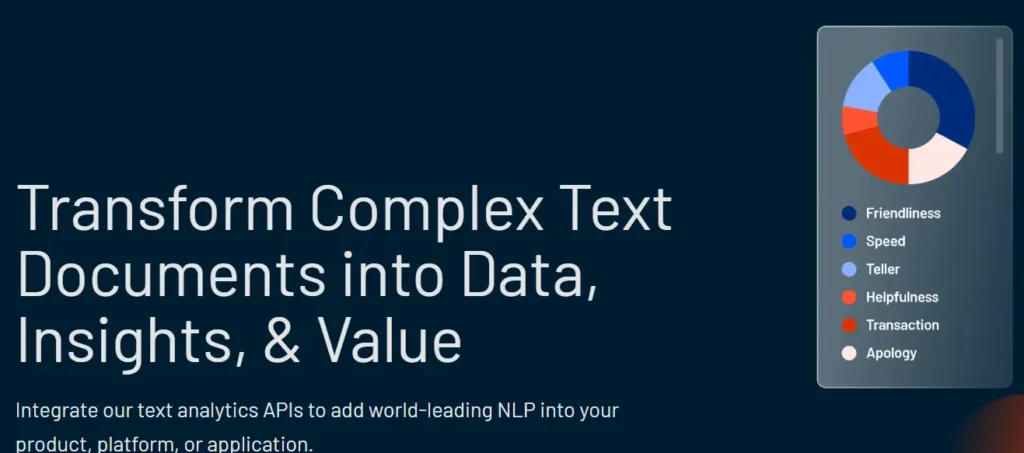
Lexalytics is a powerful AI-driven sentiment analysis tool designed for businesses, marketers, and researchers to extract insights from unstructured text data. It specializes in processing social media posts, reviews, customer feedback, and survey responses to determine sentiment, emotion, and intent. With its advanced natural language processing (NLP) capabilities, Lexalytics helps organizations understand customer opinions, brand perception, and market trends in real time, enabling data-driven decision-making.
Key Features:
- Advanced Sentiment Analysis: Identifies sentiment at a granular level, including positive, negative, and neutral tones, as well as complex emotions like joy, anger, and sadness.
- Entity Recognition: Extracts entities such as names, locations, brands, and products, allowing detailed sentiment analysis at the entity level.
- Intent Detection: Analyzes text to identify customer intent, such as purchase intent, complaints, or inquiries.
- Multilingual Support: Supports over 20 languages, making it suitable for global brands and organizations.
- Customizable Models: Offers customization to fine-tune sentiment models based on industry-specific terminology and context.
- Deployment Flexibility: Available as both a cloud-based API and on-premises solution for secure data processing.
Pricing Plans:
- Free Trial: Limited access to explore core features before committing to a subscription.
- Cloud API Plan: Pay-as-you-go model based on the number of API calls and processing volume, suitable for startups and small businesses.
- Enterprise Plan: Custom pricing – Includes advanced customization, dedicated support, and deployment options for large organizations.
- On-Premises Solution: Tailored pricing for companies requiring data security and compliance with internal policies.
Pros:
- Highly Accurate Sentiment Analysis: Advanced NLP algorithms ensure accurate sentiment detection, even in complex contexts.
- Granular Insights: Detailed emotion and intent analysis provides deep insights into customer behavior.
- Customizable Models: Adaptable to industry-specific language, improving relevance and accuracy.
- Scalable and Flexible: Cloud API and on-premises deployment options cater to different organizational needs.
- Multilingual Capabilities: Ideal for global brands and businesses targeting diverse markets.
Cons:
- Complex Setup for Beginners: Initial setup and customization require some technical knowledge.
- Pricing for High Volume: Can be expensive for businesses processing large volumes of text data.
- Learning Curve for Advanced Features: Advanced customization options may take time to master.
- Requires Clean Data: Accuracy can be impacted by noisy or unstructured data inputs.
How Lexalytics Compares to Other Sentiment Analysis Tools: Compared to Brand24, which focuses more on social media monitoring and brand mentions, Lexalytics offers more advanced sentiment analysis and entity recognition capabilities. While MonkeyLearn provides user-friendly no-code solutions, Lexalytics is better suited for organizations needing high customization and detailed insights. Lexalytics also outperforms traditional text analysis tools with its advanced emotion detection and intent analysis, making it ideal for complex customer feedback analysis.
Why Choose Lexalytics? Lexalytics is the go-to tool for businesses needing advanced sentiment analysis with customizable models. Its detailed emotion and intent detection provide deep insights into customer behavior, helping brands make informed decisions. The flexibility of cloud-based and on-premises deployment options ensures scalability and data security, making it suitable for both startups and large enterprises.
Perfect For:
- Marketing teams analyzing social media sentiment and brand perception.
- Customer support teams identifying complaints, inquiries, and customer emotions.
- Market researchers extracting insights from surveys and reviews.
- Global brands requiring multilingual sentiment analysis.
Lexalytics stands out as the top choice for advanced sentiment analysis, offering detailed insights and customizable models that help businesses understand customer emotions and intent. It’s an essential tool for data-driven marketing and customer experience strategies in 2025.
Talkwalker: The Best AI Tool for Social Media Sentiment Analysis and Brand Monitoring

Talkwalker is a comprehensive social listening and analytics platform designed to help brands, marketers, and agencies monitor their online presence, analyze sentiment, and track brand reputation. It specializes in processing social media posts, news articles, blogs, and customer reviews to provide real-time insights into public sentiment, engagement trends, and emerging topics. With its advanced natural language processing (NLP) capabilities, Talkwalker helps businesses make informed marketing decisions and protect brand reputation.
Key Features:
- Social Listening and Monitoring: Tracks brand mentions across social media platforms, news sites, forums, and blogs, providing a 360-degree view of online presence.
- Advanced Sentiment Analysis: Identifies positive, negative, and neutral sentiments with high accuracy, even in complex contexts such as sarcasm or irony.
- Visual Recognition: Uses AI-powered image recognition to detect brand logos and products in social media images and videos.
- Trend Analysis and Alerts: Identifies emerging trends and sends real-time alerts for brand mentions, crises, or viral content.
- Influencer Identification: Analyzes influencer impact and reach, helping brands collaborate with key opinion leaders.
- Competitive Benchmarking: Compares brand performance against competitors, providing insights into industry trends and market positioning.
- Customizable Dashboards: Offers fully customizable dashboards and reports, making data visualization and presentation easy.
Pricing Plans:
- Starter Plan: Designed for small businesses with basic social listening and sentiment analysis features. Pricing is available upon request.
- Professional Plan: Ideal for medium-sized businesses needing advanced analytics and influencer tracking. Custom pricing based on requirements.
- Enterprise Plan: Tailored for large organizations and agencies with full access to advanced features, including visual recognition and competitive benchmarking. Custom pricing with dedicated support.
- Free Trial: Available for businesses to explore core features before committing to a subscription.
Pros:
- Comprehensive Social Listening: Tracks brand mentions across multiple channels, including social media, news sites, blogs, and forums.
- Accurate Sentiment Analysis: Advanced NLP ensures accurate sentiment detection, even in complex scenarios.
- Visual Recognition Technology: Unique capability to track brand logos and products in images and videos.
- Real-Time Alerts: Instant notifications for crises or viral trends, enabling proactive reputation management.
- Competitive Benchmarking: In-depth competitor analysis provides valuable market insights.
Cons:
- Premium Pricing: More expensive compared to other sentiment analysis tools, particularly for the Enterprise plan.
- Complex Interface: Some users find the interface overwhelming due to the extensive range of features.
- Learning Curve: Advanced features and customization options require time to master.
- Occasional Data Lag: Data from certain platforms may experience slight delays in real-time tracking.
How Talkwalker Compares to Other Sentiment Analysis Tools: Compared to Brand24, which is more focused on social media monitoring and engagement tracking, Talkwalker offers a broader range of analytics, including image recognition and competitive benchmarking. While MonkeyLearn is ideal for text analysis with a user-friendly no-code interface, Talkwalker provides a more comprehensive solution for brand monitoring and social listening. It also surpasses Lexalytics in terms of visual recognition and influencer analysis, making it a powerful tool for brand reputation management.
Why Choose Talkwalker? Talkwalker is perfect for brands and agencies looking to monitor online presence, track brand sentiment, and analyze market trends in real-time. Its advanced visual recognition and influencer tracking capabilities make it particularly valuable for marketing campaigns and brand reputation management. The customizable dashboards and competitive benchmarking features provide actionable insights, helping brands stay ahead of the competition.
Perfect For:
- Marketing teams monitoring brand mentions and sentiment on social media.
- PR agencies managing brand reputation and crisis communication.
- Brands tracking influencer campaigns and measuring their impact.
- Competitive intelligence teams analyzing market trends and competitor performance.
Talkwalker’s powerful social listening and sentiment analysis features make it a top choice for brand monitoring and strategic marketing in 2025. Its advanced visual recognition and competitive benchmarking capabilities ensure brands stay informed and proactive in managing their online presence.
Conclusion: Embracing the Future of Social Media with AI
As we’ve journeyed through the innovative AI tools making waves in the social media landscape of 2025, one fact remains clear: artificial intelligence is not just a supplementary aid but an integral game-changer for brands, content creators, and marketers alike. From the depths of research, and sentiment analysis, to content generation and management, these tools have showcased their indispensable value in optimizing our digital strategies. Whether you’re a seasoned social media veteran or just stepping onto the digital stage, integrating these AI tools into your arsenal can pave the way for heightened engagement, more informed decisions, and a competitive edge in an ever-evolving online world. As the line between AI and social media continues to blur, those who harness their combined power will undoubtedly lead the narrative of the digital future.
See also: What is the best tool for social media management?











